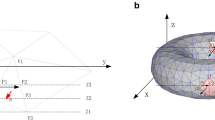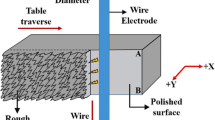Abstract
Pores can easily form in the geometric center and sharp corner lap joints of solid components with polygonal cross-sections fabricated by wire and arc additive manufacturing. To solve these problems, this paper proposes a composite path planning method and a sharp corner correction strategy. The composite path planning method consists of the zigzag path and the contour offsetting path. The zigzag path is used to fill the interior of the component and eliminates pores formed by traditional filling paths. The contour offset path is used to improve the geometric precision of the component. Filling paths are connected to create a closed path, which reduces arc striking and arc extinguishing during the manufacturing process. By exploring the distance between two vertices of a sharp corner lap of the outer contour path, it was found that pores form in the sharp corner lap when the angle of the sharp corner is less than 58.65°; therefore, the sharp corner correction strategy is proposed to correct the sharp corner lap path in the outer contour path. Experimental results show that the composite path filling method and the sharp corner correction strategy can eliminate pores between the geometric center and the sharp corner lap joints of components, thereby improving surface morphology and forming quality of components with complex polygonal cross-sections.
















Similar content being viewed by others
References
Fu Y, Wang G, Zhang H (2017) Optimization of surface appearance for wire and arc additive manufacturing of bainite steel. Int J Adv Manuf Technol 91(1–4):301–313
Williams SW, Martina F, Addison AC, Ding J, Colegrove P (2015) Wire + arc additive manufacturing. Mater Sci Technol 32(7):641–647
Ding J, Colegrove P, Mehnen J (2011) Thermo-mechanical analysis of wire and arc additive layer manufacturing process on large multi-layer parts. Comput Mater Sci 50:3315–3322
Li F, Chen S, Wu Z, Yan Z (2018) Adaptive process control of wire and arc additive manufacturing for fabricating complex-shaped components. Int J Adv Manuf Technol 96:871–879
Yang YQ, Weng CW (2019) Research on the process and prediction model for size of 316L stainless steel fabricated by plasma arc additive manufacturing. J Mech Eng:1–8
Dunlavey MR (1983) Efficient polygon-filling algorithms for raster displays. ACM Trans Graph 2(4):264–273
Park SC, Choi BK (2000) Tool-path planning for direction-parallel area milling. Comput Aided Des 32(1):17–25
Rajan VT, Srinivasan V, Tarabanis KA (2001) The optimal zigzag direction for filling a two-dimensional region. Rapid Prototyp J 7(5):231–241
Farouki RT, Koenig T, Tarabanis KA (1995) Path planning with offset curves for layered fabrication processes. J Manuf Syst 14(5):355–368
Ren F, Sun Y, Guo D (2009) Combined reparameterization-based spiral toolpath generation for five-axis sculptured surface machining. Int J Adv Manuf Technol 40(7–8):760–768
Jin GQ, Li WD, Gao L (2013) An adaptive process planning approach of rapid prototyping and manufacturing. Robot Comput Integr Manuf 29(1):23–38
Ding D, Pan Z, Cuiuri D, Li H (2015) A multi-bead overlapping model for robotic wire and arc additive manufacturing (WAAM). Robot Comput Integr Manuf 31:101–110
Florent M, Helen L, Ding JL, Filomeno M, Gianrocco M, Stewart W (2019) A modular path planning solution for wire + arc additive manufacturing. Robot Comput Integr Manuf 46(12)
Ding D, Pan Z, Cui Uri D (2016) A practical path planning methodology for wire and arc additive manufacturing of thin-walled structures. Robot Comput Integr Manuf 34:8–19
Panchagnula JS, Simhambhatla S (2018) Manufacture of complex thin-walled metallic objects using weld-deposition based additive manufacturing. Robot Comput Intergr Manuf 49:194–203
Li Y, Han Q, Zhang G (2018) A layers-overlapping strategy for robotic wire and arc additive manufacturing of multi-layer multi-bead components with homogeneous layers. Int J Adv Manuf Technol 96:9–12
Katou M, Oh J, Miyamoto Y (2007) Freeform fabrication of titanium metal and intermetallic alloys by three-dimensional micro welding. Mater Des 28(7):2093–2098
Dwivedi R, Kovacevic R (2004) Automated torch path planning using polygon subdivision for solid freeform fabrication based on welding. J Manuf Syst 23(4):278–291
Zhu C, Tang J (2010) The application of concave polygon convex decomposition algorithm to rapid prototyping. Mod Manuf Eng (2):53–55
Fang X, Bai H, Yao Y, Zhang L, Lu B (2019) Research on multi-bead overlapping process of wire and arc additive manufacturing based on cold metal transfer. Chin J Mech Eng:1–7
Funding
This research is funded by the National Natural Science Foundation of China (grant nos. U1733125 and 51975410), the Natural Science Foundation of Tian Jing city (grant nos. 18JCYBJC19100, 17JCZDJC38700, and 18JCYBJC18700), and Tianjin Municipal Education Commission Scientific Research Project (2019KJ011).
Author information
Authors and Affiliations
Corresponding author
Additional information
Publisher’s note
Springer Nature remains neutral with regard to jurisdictional claims in published maps and institutional affiliations.
Rights and permissions
About this article
Cite this article
Liu, H.H., Zhao, T., Li, L.Y. et al. A path planning and sharp corner correction strategy for wire and arc additive manufacturing of solid components with polygonal cross-sections. Int J Adv Manuf Technol 106, 4879–4889 (2020). https://doi.org/10.1007/s00170-020-04960-4
Received:
Accepted:
Published:
Issue Date:
DOI: https://doi.org/10.1007/s00170-020-04960-4




